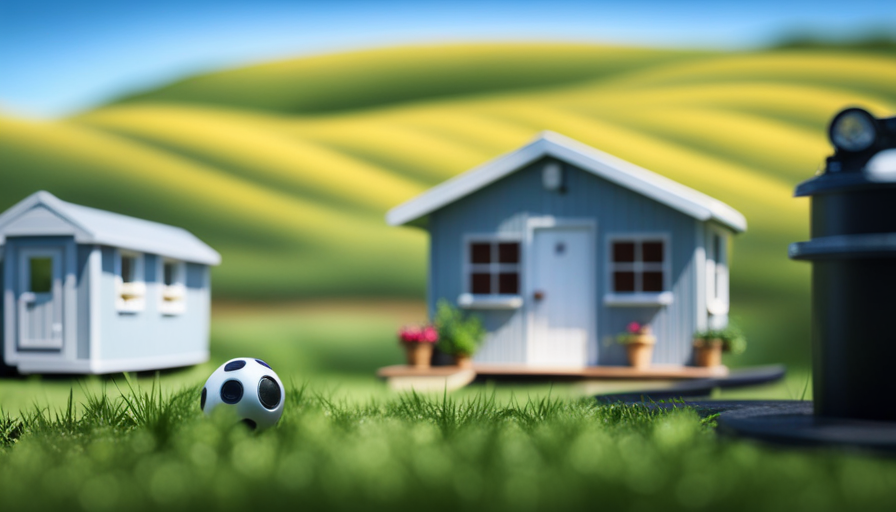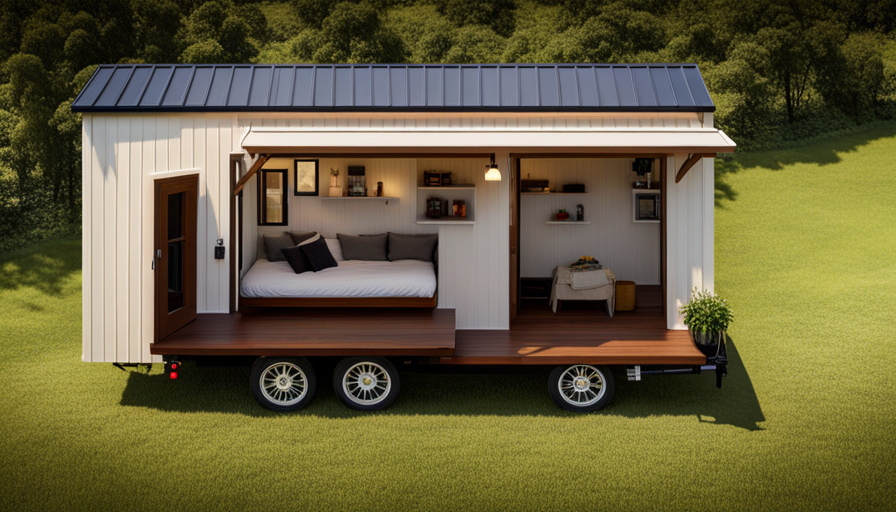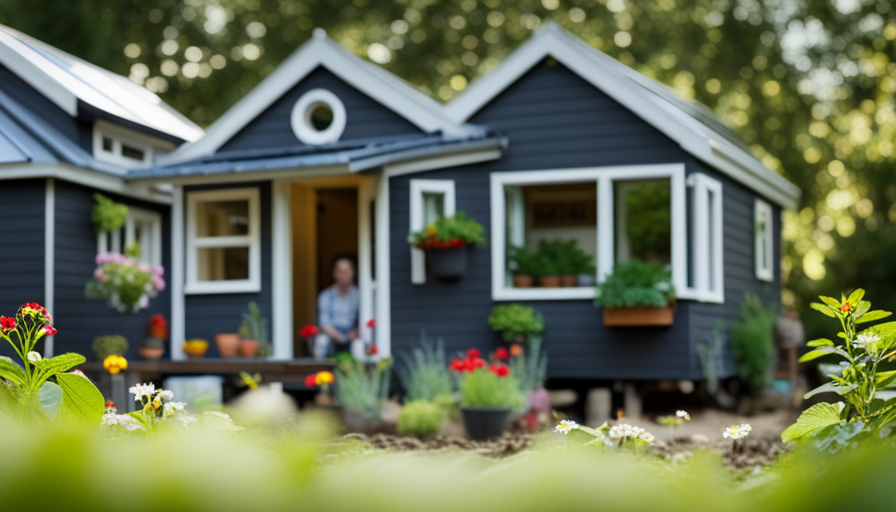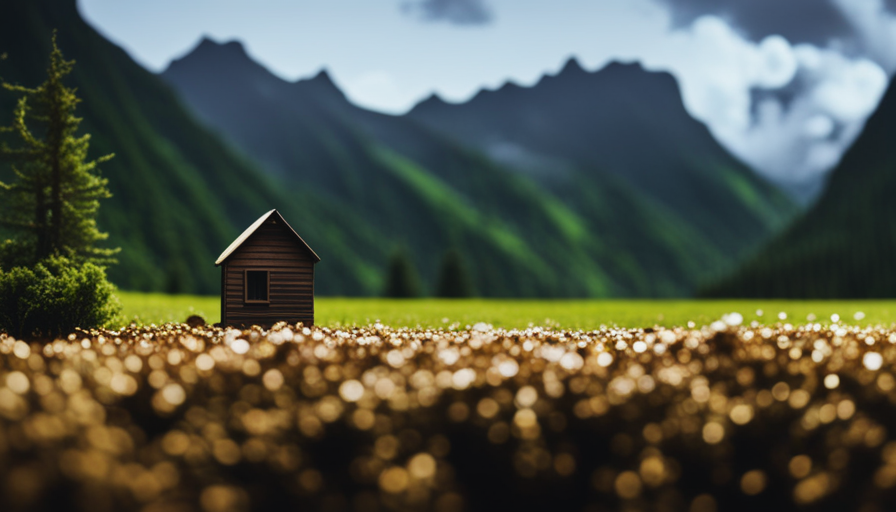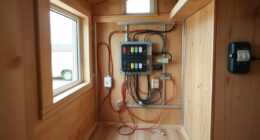Have you ever daydreamed about escaping the hustle and bustle of city life and finding solace in a cozy home nestled in the peacefulness of nature? If this idea speaks to you, then buying a tiny house with some land might be the perfect solution.
Imagine waking up to the sound of birdsong, surrounded by breathtaking landscapes, and having the freedom to live a simpler, more sustainable lifestyle.
In this article, I will guide you through the process of purchasing a tiny house and land, step by step. From determining your budget and financing options to understanding the legal requirements and securing financing, I will provide you with all the knowledge and tools you need to make your dream a reality.
So, if you’re ready to embark on this exciting journey, let’s dive in and explore the world of tiny house living!
Key Takeaways
- Determine budget and explore financing options before starting the search for a tiny house and land.
- Choose the right location that aligns with amenities and lifestyle preferences.
- Familiarize with legal and zoning requirements to avoid conflicts with authorities.
- Inspect the land and conduct a title search to ensure a secure investment.
Determine Your Budget and Financing Options
Before you start searching for your dream tiny house and land, it’s crucial to determine your budget and explore financing options. Budgeting constraints play a significant role in this process, as they’ll dictate the size and type of tiny house you can afford and the location you can consider.
Start by evaluating your financial situation and setting a realistic budget. Consider factors such as your income, expenses, and any existing debts or obligations. This’ll give you a clear idea of how much you can comfortably allocate towards your tiny house and land purchase.
Once you have your budget in place, it’s time to explore financing options. There’re several available loan options specifically designed for tiny house purchases. Research traditional banks, credit unions, and online lenders that offer tiny house loans. Compare interest rates, loan terms, and eligibility requirements to find the best fit for your needs.
Additionally, consider alternative financing methods such as personal loans, crowdfunding, or seller financing. Each option has its advantages and disadvantages, so take the time to weigh them carefully.
Now that you have a clear understanding of your budget and financing options, it’s time to research and choose the right location for your tiny house and land. This step is crucial as it’ll determine the lifestyle you can lead and the amenities available to you.
Research and Choose the Right Location
When it comes to finding the perfect spot for your dream home, picture yourself nestled in a serene oasis, where the world fades away and tranquility engulfs your senses. Choosing the right location is crucial when buying a tiny house and land. It’s not just about the physical surroundings, but also about evaluating the local community and its amenities. To help you make an informed decision, consider the following factors:
| Proximity to Essential Services | Access to Nature | Sense of Community |
|---|---|---|
| Is the location close to grocery stores, healthcare facilities, and other essential services? | Does the area offer nature trails, parks, or lakes for outdoor activities? | Is there a strong sense of community with neighborhood events and gatherings? |
Evaluating these aspects will ensure that the location aligns with your lifestyle and preferences. Additionally, it’s important to consider the size and design of the tiny house in relation to the chosen location. By doing so, you can ensure that your dream home seamlessly fits into the surroundings and maximizes the benefits of the chosen spot. So, let’s explore how to consider the size and design of the tiny house in the next section.
Consider the Size and Design of the Tiny House
Imagine yourself stepping into a perfectly designed sanctuary that effortlessly blends with its surroundings, allowing you to fully embrace the peacefulness and beauty of your chosen location.
When considering the size of your tiny house, it’s important to assess your needs and lifestyle. Keep in mind that while the idea of a tiny house is to downsize, you still need to ensure that it has enough space to accommodate your daily activities comfortably. Think about the number of bedrooms, bathrooms, and living areas you require, as well as storage options for your belongings.
In terms of design options, the possibilities are endless. You can choose from a variety of architectural styles, such as modern, rustic, or minimalist. Consider the materials you prefer and how they’ll fit into the natural landscape of your chosen location. Additionally, think about the layout and functionality of the house. Will it have an open floor plan or separate rooms? Will it include features like a loft or a kitchen island?
As you envision your perfect tiny house, remember to take into account both size considerations and design options to create a space that suits your needs and personal taste. Once you have a clear idea of what you want, it’s time to find a reputable builder or manufacturer who can bring your vision to life.
Find a Reputable Builder or Manufacturer
To create your dream tiny home, start by seeking out a trusted builder or manufacturer who can transform your vision into a reality. Finding a reputable builder is crucial to ensure that your tiny house is built to high standards and meets all necessary codes and regulations.
Here are some key factors to consider when searching for a builder:
-
Experience: Look for builders who’ve got a proven track record of constructing quality tiny houses. Check their portfolio and read customer reviews to get an idea of their workmanship and professionalism.
-
Customization: Choose a builder who offers customization options to tailor the tiny house to your specific needs and preferences. This’ll allow you to create a space that truly reflects your style and lifestyle.
-
Budget-Friendly: Consider builders who offer tiny house financing options or can work within your budget. They should be transparent about costs and provide a detailed breakdown of expenses.
By partnering with a reputable builder, you can have peace of mind knowing that your tiny house will be built with care and expertise. Once you’ve found the right builder, it’s important to understand the legal and zoning requirements for placing your tiny house on land. This’ll ensure that you can enjoy your tiny home without any legal hurdles or restrictions.
Understand the Legal and Zoning Requirements
Before embarking on your tiny home journey, it’s essential to familiarize yourself with the legal and zoning requirements to ensure a smooth and hassle-free placement of your compact abode. Understanding the legal requirements and zoning regulations will help you avoid any potential issues or conflicts with local authorities.
Legal requirements vary from state to state and even within different municipalities. It’s crucial to research and adhere to any building codes, permits, or licenses that may be required. Additionally, familiarize yourself with any specific regulations regarding tiny homes, such as size limitations or minimum square footage requirements.
Zoning regulations dictate how land can be used and what structures can be built on it. Some areas have specific zoning classifications for tiny homes, while others may not allow them at all. It’s crucial to ensure that the land you plan to purchase is zoned appropriately for your tiny home.
To help you better understand the legal and zoning requirements, here’s a table outlining some key considerations:
| Legal Requirements | Zoning Regulations |
|---|---|
| Building codes | Zoning classifications |
| Permits and licenses | Land use restrictions |
| Size limitations | Minimum square footage requirements |
By familiarizing yourself with these legal and zoning requirements, you can make informed decisions when purchasing a tiny house and land. In the subsequent section, we will discuss how to inspect the land and conduct a title search to ensure a secure investment.
Inspect the Land and Conduct a Title Search
After understanding the legal and zoning requirements for buying a tiny house and land, it’s essential to take the next step: inspecting the land and conducting a title search. This crucial phase ensures that you’re making a well-informed decision and protects you from potential issues down the road.
When inspecting the land, it’s advisable to hire a professional surveyor or land assessor who can assess the property’s boundaries, topography, and potential hazards. They’ll provide you with a detailed report that can help you make an informed decision.
Additionally, it’s crucial to conduct a title search to verify the property’s ownership and any existing liens or encumbrances. A title search involves examining public records, such as deeds, mortgages, and tax records, to ensure that the seller has the legal right to sell the property and that there are no outstanding claims or disputes. This step is essential to protect your investment and avoid any legal complications in the future.
Once the land inspection and title search are complete, you can move on to the exciting part of negotiating the purchase price and terms. By carefully considering the information gathered during the inspection and title search, you can confidently enter into negotiations, knowing that you’ve done your due diligence.
Negotiate the Purchase Price and Terms
Once you’ve assessed the land and verified the title, it’s time to roll up your sleeves and dive into negotiating the price and terms of your dream property.
Negotiating the purchase price and terms is a crucial step in acquiring a tiny house and land. To successfully negotiate, it’s important to have a clear understanding of your budget and the market value of similar properties in the area. This knowledge will help you determine a reasonable starting point for your negotiations.
One effective negotiation strategy is to begin with a lower offer than your maximum budget, allowing room for counteroffers and potential compromises. This approach can give you some leverage in the negotiation process. Additionally, being flexible with your terms can also be advantageous. For example, you could offer a quicker closing date or agree to take on certain responsibilities, such as repairs or maintenance.
Pricing considerations should go beyond just the purchase price. Take into account any additional costs, such as property taxes, utilities, or homeowners association fees. These expenses can significantly impact your overall budget and should be factored in when negotiating the final price.
Once you’ve successfully negotiated the purchase price and terms, the next step is to secure financing for the land and tiny house. Transitioning into the subsequent section, it’s crucial to explore various financing options that cater to your specific needs and financial situation.
Secure Financing for the Land and Tiny House
To successfully acquire your ideal property, you must now secure financing for both the land and the charming abode. Securing financing is a crucial step in the process of buying a tiny house and land. It involves finding the right lender who understands the unique nature of this type of purchase.
When it comes to securing financing, there are a few important factors to consider. First, you’ll want to research different lenders and compare their loan terms and interest rates. Look for lenders who specialize in tiny house financing or have experience with unconventional properties.
Second, gather all the necessary documents, such as income statements, credit history, and proof of employment. This will help streamline the loan application process.
Finally, be prepared to negotiate the terms of the loan, including the down payment amount and repayment schedule.
Incorporate an unordered 3 item bullet list in markdown format to convey a deeper meaning for the audience:
- Research different lenders and compare loan terms and interest rates
- Gather all necessary documents for the loan application
- Be prepared to negotiate the terms of the loan
Securing financing for your tiny house and land is a crucial step on your journey. Once this is done, you can move on to planning for utilities and infrastructure.
Planning for utilities and infrastructure is the next important step in the process of buying a tiny house and land.
Plan for Utilities and Infrastructure
Now that you’ve secured financing for your dream property, it’s time to dive into planning for the essential utilities and infrastructure.
Planning utilities and infrastructure for your new tiny house and land is crucial for a comfortable and sustainable living experience. One option is to connect your tiny house to existing utility lines, such as water, electricity, and sewage systems. This will require working with local utility companies and ensuring your property is within their service area.
Another option is to explore off-grid alternatives, such as solar panels for electricity and rainwater harvesting systems for water. These off-grid options can provide you with a self-sufficient and environmentally friendly way of living.
Additionally, you’ll need to consider the infrastructure required for your tiny house, such as driveways, parking spaces, and any necessary permits for construction.
Planning and budgeting for these utilities and infrastructure elements will ensure a smooth transition into your new home.
With the utilities and infrastructure in place, you can now move on to the exciting phase of enjoying your new tiny house and land!
Enjoy Your New Tiny House and Land!
Immerse yourself in the joy and fulfillment that comes with embracing the unique lifestyle of living in a cozy, sustainable haven nestled on your very own slice of paradise. Owning a tiny house and land isn’t just about the practicality and efficiency, but also about creating a space that reflects your personal style and taste. Here are some current trends and tips to consider when decorating your new tiny house:
-
Minimalism: Embrace the beauty of simplicity by decluttering and keeping only the essentials. Opt for multi-functional furniture pieces that maximize space.
-
Natural Elements: Bring the outdoors in by incorporating natural materials like wood and stone. Use plants and greenery to add life and freshness to your space.
-
Smart Storage Solutions: Utilize every nook and cranny by investing in creative storage solutions such as hidden compartments, built-in shelves, and wall-mounted organizers.
-
Personal Touches: Make your tiny house feel like home by adding personal touches. Display cherished mementos, hang artwork, or use accent pillows and throws to infuse your personality into the space.
By following these new tiny house trends and incorporating your own unique style, you can create a beautiful and functional space that perfectly suits your lifestyle. Enjoy the freedom and creativity that comes with living in a tiny house, and savor the satisfaction of owning your very own piece of heaven.
Frequently Asked Questions
What are the maintenance costs associated with owning a tiny house and land?
What are the maintenance costs associated with owning a tiny house and land? Budgeting for upkeep is crucial to ensure the longevity of your investment. It’s important to consider long-term expenses such as repairs, utility bills, and landscaping.
How much you spend on maintenance will depend on factors like the size of your tiny house and the condition of the land. By carefully planning and setting aside funds for maintenance, you can keep your tiny house and land in good shape for years to come.
Can I rent out my tiny house when I’m not using it?
Yes, you can rent out your tiny house when you’re not using it. However, there are legal considerations to keep in mind. Depending on your location, there may be zoning regulations or homeowner association rules that restrict or regulate short-term rentals.
It’s important to research and understand the local laws and obtain any necessary permits or licenses. Additionally, you may want to consider liability insurance to protect yourself and your property while renting out your tiny house.
Are there restrictions on the types of materials I can use to build my tiny house?
There may be restrictions on the types of materials that can be used to build a tiny house, depending on local building permits and regulations. It’s important to research and comply with these requirements to ensure a smooth construction process.
Additionally, using eco-friendly materials is a popular choice for building tiny houses, as they promote sustainability and reduce environmental impact. Consider materials such as reclaimed wood, recycled metal, or low VOC paints to create a greener and healthier living space.
What are the insurance requirements for a tiny house and land?
Insurance coverage for a tiny house and land is crucial to protect your investment. The cost factors can vary depending on factors such as the value of the property and the type of coverage you choose. It’s like building a strong foundation for your house – insurance provides a safety net in case of accidents, natural disasters, or theft.
It’s important to consult with an insurance agent who specializes in tiny houses to ensure you have the right coverage for your unique needs.
How do I ensure that the land is suitable for building a tiny house?
To ensure that the land is suitable for building a tiny house, it’s important to consider land suitability and obtain the necessary building permits. Before purchasing the land, it’s crucial to conduct a thorough assessment of the site to ensure it meets the necessary requirements for building a tiny house.
This includes checking zoning laws, soil quality, access to utilities, and any potential environmental issues. Additionally, obtaining the appropriate building permits is essential to ensure compliance with local regulations and ensure a smooth construction process.
Conclusion
In conclusion, buying a tiny house and land is an exciting adventure that requires careful planning and consideration. By determining your budget, researching the right location, and finding a reputable builder, you can make your dream of owning a tiny house a reality.
Just like building a puzzle, each piece of the process fits together to create a beautiful and unique picture. So, take the leap, embrace the simplicity, and enjoy the freedom that comes with owning a tiny house and land. It’s a journey worth taking!
Hi, I’m Emma. I’m the Editor in Chief of Tiny House 43, a blog all about tiny houses. While tree houses are often associated with childhood, they can be the perfect adult retreat. They offer a cozy space to relax and unwind, surrounded by nature. And since they’re typically built on stilts or raised platforms, they offer stunning views that traditional homes simply can’t match. If you’re looking for a unique and romantic getaway, a tree house tiny house might just be the perfect option.
